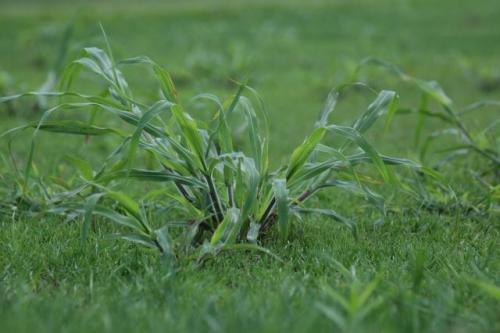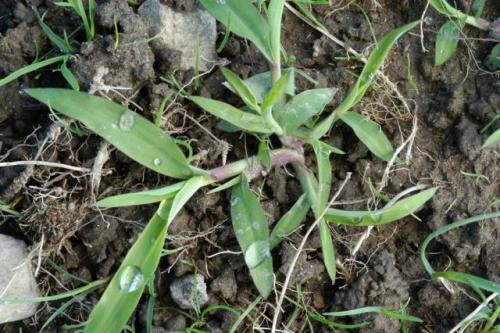
Bulletin E0002TURF
Crabgrass Control in Home Lawns
DOWNLOAD
May 28, 2015 - Ronald Calhoun
Homeowners and professionals alike spend a lot of time and money trying to eliminate crabgrass from their turfgrass stands. Numerous products for crabgrass control are widely available. Most of these compounds are extremely effective at reducing crabgrass pressure in a given year. Like most weeds, however, crabgrass can be an indicator of other problems with the growing conditions in your lawn. These conditions must be corrected to achieve long-term crabgrass control.
Crabgrass is one of the most prevalent grassy weeds found in Michigan lawns. Crabgrass thrives in full sunlight and high temperatures and can easily out compete common cool-season grasses under these conditions. Crabgrass is in a group of plants known as summer annuals. These plants have a life of less than one year. Summer annuals germinate in the spring, grow through the summer and die with the first hard frost. These plants produce a tremendous amount of seed in the mid- to late summer when the day length starts to shorten. These seeds ensure next year’s crop of weeds but can also remain dormant in the soil for several years before germinating. It is likely that if you have crabgrass in your lawn, it will be there next year, too. “One year's seeding equals seven years weeding,” as weed scientists like to say.

Crabgrass is a very common weed problem in lawns.
Cultural Control
Weed management in turfgrass stands can be accomplished in various ways. Traditional methods include cultural management and mechanical and chemical controls. The primary and most effective weed control tactic in a lawn is proper mowing. In fact, it has been estimated that regular mowing eliminates some 80 percent of weedy species. Other cultural practices, such as judicious fertilization, can further reduce weed competition by increasing turfgrass vigor. Open and weak turfgrass areas promote crabgrass infestations because of higher soil temperatures, which enhance germination and decrease competition. The best defense against weed invasion is a dense, healthy turfgrass stand. This is particularly effective for annual weeds such as crabgrass that establish from seed every year. A thick turf canopy can effectively shade the soil and reduce the number of seedlings that are able to establish.

Crabgrass germinates in the spring, quickly filling in bare spots.
Preemergence Timing
Knowing when crabgrass is likely to be present is helpful in proper identification and control. Homeowners who complain of crabgrass infestations in April and May are usually identifying tall fescue, nimblewill or quackgrass. Crabgrass germination typically begins in early May when soil temperatures reach 62 degrees Fahrenheit at a depth of 1 to 2 inches, or about two weeks after the forsythia blooms begin to drop. Heat accumulation or growing degree-days are a great way to estimate soil temperatures from readily available weather station data. Visit GDDTracker to get customized, weather-based, email alerts for your location.
To be effective, preemergence herbicides must be in place before germination occurs. Preemergence treatments are preferred because they are generally more effective for crabgrass control and less injurious to the turfgrass than postemergence treatments. In general, preemergence herbicides should be applied when soil temperatures reach 50 to 55 degrees Fahrenheit, or when forsythia is in full bloom. This will allow the preemergence herbicide to form a barrier before the crabgrass seedlings emerge. Preemergence herbicides work by inhibiting the growth of young seedlings. These products do not eliminate established plants and must be applied before germination begins. In Michigan, this is usually around April 15 but can be as late as May 1. Applications made very early in the spring have potential to break down before the end of the germination window and are, for the most part, not recommended. This is a particular problem in the three out of 10 years when late-season conditions are conducive for a second germination flush. Delaying preemergence applications in a very cool or dry spring would provide better seasonlong control because crabgrass germination is also delayed under these situations. Nearly all of the commercially available preemergence herbicides are very effective when applied properly.
Postemergence Applications
Once crabgrass has established, preemergence herbicides will not be effective. Only a few herbicides are available for use on young plants. Metharsenate (MSMA) is the most common herbicide found in postemergence crabgrass products available to homeowners. Two or three applications spaced seven to 10 days apart are often needed to achieve acceptable control. Unfortunately, some turfgrass discoloration often accompanies applications of metharsenate herbicides. Dithiopyr (Dimension, Spectracide Crabgrass) also has postemergence activity on one- to three-leaf crabgrass.
Early postemergence applications of dithiopyr will control young crabgrass plants and provide a preemergence barrier that can last the entire season. Metharsenate and dithiopyr do not provide reliable postemergence control of mature crabgrass. Professional lawn services can control mature crabgrass with applications of fenoxyprop (Acclaim Extra) or quinclorac (Drive). These products are relatively new and not available in garden centers.
In general, preemergence applications are preferred in lawns with a history of crabgrass pressure because of the difficulties associated with postemergence control. Preemergence herbicides and proper turfgrass management are the best combination for long-term crabgrass suppression. Be sure to read, understand and follow all directions on the herbicide label.
Common Preemergence Crabgrass Herbicides
| Common Name | Trade Name | Performance |
|---|---|---|
| benefin | Balan | Good |
| benefin+trifluralin | Team, Team Pro, 'Store Brand' Crabgrass | Excellent |
| dithiopyr | Dimension, Meijer Crabgrass, Spectracide Crab | Excellent |
| pendimethalin | Scott's Weedgrass, Lesco Pre-M | Excellent |
| prodiamine | Barricade, Vigoro | Excellent |



 Print
Print Email
Email


